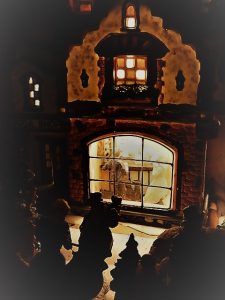Online Content
Ghosts of Christmas Past: Dickens and all his Christmas carols
December, 2016

Christmas wouldn’t be Christmas without watching one of the many versions of Charles Dickens’ A Christmas Carol. From plays at local theatres to classic and up-to-date movie versions, this 173-year-old short story is one of the definitive messages of Christmas. If you’re wanting to branch out of your usual viewing of the movie, there’s a full list of every version at the end of this article. But, first, a little history of how Dickens revived the yuletide holiday with his story.
When A Christmas Carol was published, Dickens was facing dire straits in his professional and personal life. The public, who had adored his prose and opinions for many years, had fallen out of favour with him. Because his serials weren’t selling and he was having trouble meeting his publisher’s deadline with Martin Chuzzlewit, bankruptcy was right around the corner. With a wife and four kids, this severe dip in his income was causing him severe stress. But he was no stranger to poverty. His father had been arrested for debt when Dickens was only 12 years old. This very early lesson of what it was like to be poor became a part of his life, and was always the backbone message of his future writings.
He accepted an invitation from a friend to give a talk to the Manchester public regarding the Athenaeum’s financial troubles. The Athenaeum in Manchester was built in 1837 as a kind of early learning resource centre; its founding members believed knowledge and how it helped better people’s lives was of the highest importance. The Athenaeum Society hoped that Dickens’ fame would help raise funds to keep the building and its society alive. At the time of this fundraiser, Manchester was in dire straits itself as unemployment at the cotton mills was between 15% and 20% due to the 1841-42 financial depression, and 3,000 people per day went to soup kitchens.
Serendipity. Fate. Art about to imitate life—Dickens’ off-the-cuff speech to the Manchester public got his creative brain cells working. He spoke of the injustice that knowledge was deemed a luxury. He pointed out that many were left to live in a great amount of ignorance, where crime and misery abound due to desperation of a person’s circumstances. He said, “…the more a man learns, the better, gentler, kinder man he must become.”
When he left the Athenaeum that night, he wandered the streets of Manchester, letting the formation of one of his most well-known stories take hold in his mind. Such was his determination to write this story that he paid for the publication of it himself. He wanted it to be ready for Christmas, which was six weeks away. Surprisingly, he got it done and all the while trying to meet his obligations to get Martin Chuzzlewit finished for his publishers. When 6,000 copies of A Christmas Carol hit bookstores on December 19, 1843, Christmas itself wasn’t the festive occasion we know of it today. England was still lingering under the Puritan movement of having Christmas and all other Christian holidays abolished, which the Protestant Royals had laid the foundations a couple centuries before. Dickens’ portrayal of family gatherings, games, drinking, parties and the all-important white Christmas had resuscitated the holiday for many people across Britain. But, it was the message of compassion, knowledge and those harmful child embodiments of “Ignorance” and “Want” that made the short story survive: ignorance feeds want and desperation is the result—if the poor remain uneducated, they will never know how to live a better life and their children will be doomed to repeat their parents. Dickens wanted to inform the public about situations not our own, that a little kindness, a little humility and a little compassion reap richer rewards than a fat bank account and a successful business.

HOW MANY MOVIE VERSIONS ARE THERE?
1901—Daniel Smith as Scrooge. First known movie version, which is silent (no music) and incomplete.
1910—Mark McDermott as Scrooge. This was done through the Thomas Edison’s Film Company. This is also a silent movie, but there is a musical soundtrack. Only 13 minutes long.
1913—Seymour Hicks as Scrooge, silent.
1935—Seymour Hicks replayed his role in this first “talkie” version.
1938—Reginald Owen as Scrooge. This version is the first American one filmed at MGM Studios. To make it family friendly, most of the scary bits were taken out.
1949—Taylor Holmes as Scrooge and this version is narrated by the Vincent Price.
1951—Alastair Sim as Scrooge. Probably the best known movie version of this story.
1954—Frederic March as Scrooge. The Chrysler Corporation produced this first-ever TV musical version.
1956—Basil Rathbone as Scrooge, who is better known for his portrayal of Sherlock Holmes.
1962—Quincy Magoo as Scrooge. Yes, that`s right, Mr. Magoo as Scrooge. This is the first-ever animated version that aired on NBC, which was also the first ever TV Christmas special.
1964—Sterling Hayden as Daniel Grudge, aka Scrooge. This movie version was produced by the Telsun Foundation, which is the TV series for the United Nations. This version came out during the time of the Cuban Missile Crisis. The writer for this script is none other than Rod Serling from The Twilight Zone.
1969—Ron Haddrick as Scrooge. Another animated version with a song sung by Scrooge’s nephew Fred.
1970—Albert Finney as Scrooge. This is a musical, and oddly enough Marley is played by Alec Guinness.
1971—Alastair Sim as Scrooge. This is an animated version and is narrated by Michael Redgrave.
1975—Mary Stewart as Carol Scrooge. Even pornographic movies has its own version of this story. It’s titled The Passions of Carol.
1983—Scrooge McDuck as, well, Scrooge. Yes, Mickey’s Christmas Carol, and was once a TV Christmas special tradition many years ago.
1984—George C. Scott as Scrooge. This TV version was nominated for an Emmy.
1988—Bill Murray as Frank Cross. An up-to-date version where Murray plays a mean TV station manager.
1988—Rowan Atkinson as Ebenezer Blackadder. The Blackadder version that puts a twist on the plot; Blackadder is the kindest man in London, but a visit from the Ghost of Christmas Past, changes that.
1992— Michael Caine as Scrooge. The Muppet Christmas Carol is pretty close to the original. Gonzo plays Dickens, who narrates the story along with Rizzo the Rat.
1998—Jack Palance as Scrooge. Probably the only western version of this story and this was shot in Canada. Ricky Schroeder from Silver Spoons is also in this.
2000—Ross Kemp as Eddie Scrooge. A modern UK version where Scrooge is loan shark. It’s darker than most previous versions.
2009—Jim Carrey as Scrooge. This computer generated version from Disney is so realistic you’ll forget it’s animated. Carrey is a whole host of voices in this version including the ghosts.
2012—Vincent Fegan as Scrooge. This version was filmed in Ireland and narrated by an actor playing “Dickens.”
…more versions to come.











